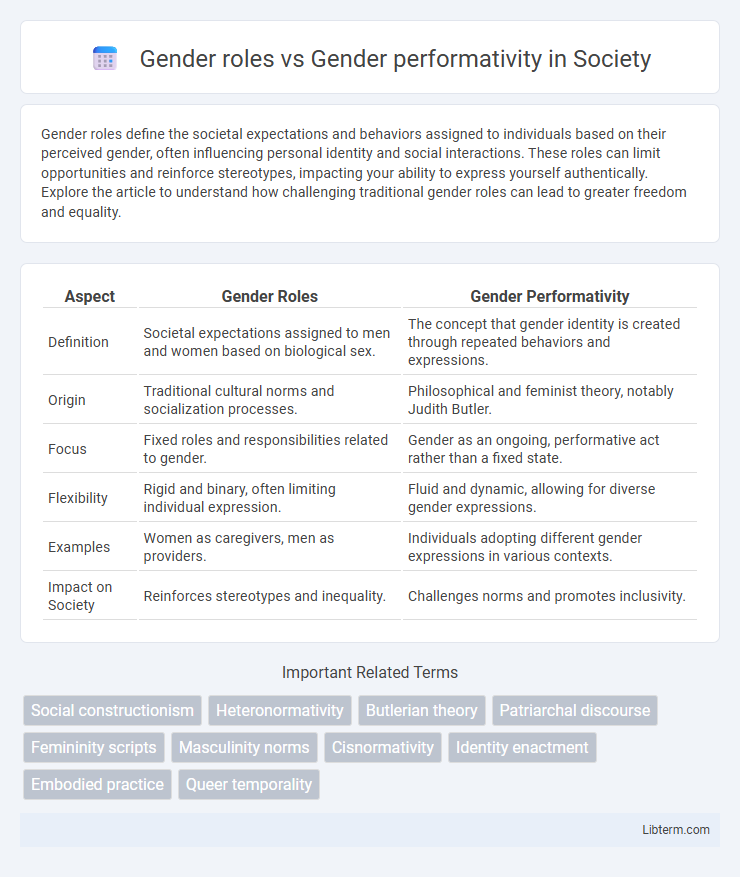Gender roles define the societal expectations and behaviors assigned to individuals based on their perceived gender, often influencing personal identity and social interactions. These roles can limit opportunities and reinforce stereotypes, impacting your ability to express yourself authentically. Explore the article to understand how challenging traditional gender roles can lead to greater freedom and equality.
Table of Comparison
| Aspect | Gender Roles | Gender Performativity |
|---|---|---|
| Definition | Societal expectations assigned to men and women based on biological sex. | The concept that gender identity is created through repeated behaviors and expressions. |
| Origin | Traditional cultural norms and socialization processes. | Philosophical and feminist theory, notably Judith Butler. |
| Focus | Fixed roles and responsibilities related to gender. | Gender as an ongoing, performative act rather than a fixed state. |
| Flexibility | Rigid and binary, often limiting individual expression. | Fluid and dynamic, allowing for diverse gender expressions. |
| Examples | Women as caregivers, men as providers. | Individuals adopting different gender expressions in various contexts. |
| Impact on Society | Reinforces stereotypes and inequality. | Challenges norms and promotes inclusivity. |
Understanding Gender Roles: Definitions and Origins
Gender roles refer to the societal expectations and norms dictating behaviors, attitudes, and responsibilities considered appropriate for individuals based on their perceived sex. These roles originate from cultural, historical, and social contexts that reinforce binary distinctions and prescribe specific functions for males and females within families, workplaces, and communities. Understanding these foundations highlights how gender roles shape identity and social interactions, contrasting with gender performativity, which emphasizes the fluid, repeated enactment of gender through actions rather than fixed traits.
Exploring Gender Performativity: Judith Butler’s Perspective
Judith Butler's concept of gender performativity challenges traditional gender roles by arguing that gender is not a fixed identity but a repeated set of actions and behaviors that produce the appearance of a stable gender. This perspective emphasizes that gender is constructed through performance rather than being an innate quality tied to biological sex. Butler's theory highlights the fluidity of gender and the possibility of subverting normative gender expectations through varied gender expressions.
Historical Context: Evolution of Gender Norms
Historical context reveals that traditional gender roles were rigidly defined by societal structures, often linking masculinity and femininity to specific behaviors and expectations. The evolution of gender norms, influenced by feminist theory and queer studies, shifted focus toward gender performativity, a concept introduced by Judith Butler emphasizing gender as an ongoing, socially constructed performance rather than a fixed identity. This shift challenges the binary understanding of gender and highlights the fluidity and variability of gender expression across different historical periods and cultures.
Socialization and the Construction of Gender Roles
Gender roles are socially constructed expectations influenced by cultural norms and socialization processes beginning in early childhood, shaping behaviors considered appropriate for each sex. Gender performativity, a concept introduced by Judith Butler, argues that gender identity is not innate but continuously produced and reinforced through repeated social performances and interactions. This perspective emphasizes that socialization does not merely transmit fixed gender roles but actively constructs and transforms gender identities through performative acts within specific social contexts.
Challenging Stereotypes: Gender Performativity in Everyday Life
Gender performativity challenges traditional gender roles by emphasizing that gender identity is constructed through repeated actions rather than innate traits. This concept reveals how everyday behaviors, language, and social interactions perform and reinforce gender stereotypes, allowing for their subversion and redefinition. By recognizing gender as fluid and performative, individuals disrupt rigid norms and create space for diverse expressions of identity beyond binary expectations.
Media Representation: Gender Roles vs. Performance
Media representation often reinforces traditional gender roles by depicting men and women in stereotypical activities and behaviors, shaping public perceptions of acceptable gender norms. In contrast, portrayals of gender performativity emphasize fluidity and individual expression, challenging binary distinctions and highlighting how gender is enacted rather than inherent. This shift towards performative narratives in media encourages audiences to question fixed roles and supports diverse identities beyond conventional expectations.
Impact of Culture and Society on Gender Behavior
Cultural norms and societal expectations shape gender roles by assigning specific behaviors and responsibilities to individuals based on their perceived gender. Gender performativity theory, introduced by Judith Butler, argues that gender is not innate but rather constructed and continuously enacted through repeated behaviors influenced by social context. These performances both reflect and reinforce societal power structures, highlighting how culture and society profoundly impact the expression and understanding of gender behavior.
The Intersection of Gender, Identity, and Power
Gender roles are socially constructed expectations that dictate appropriate behaviors and responsibilities for individuals based on their assigned sex, reinforcing existing power structures and maintaining rigid identity categories. Gender performativity, as theorized by Judith Butler, challenges these fixed roles by emphasizing gender as a dynamic, repetitive performance shaped through discourse and social interaction, disrupting traditional power relations. The intersection of gender, identity, and power reveals how performance subverts normative gender hierarchies, enabling marginalized identities to negotiate and resist dominant cultural norms.
Gender Roles in the Workplace and Education
Gender roles in the workplace and education often reinforce traditional expectations, leading to occupational segregation and disparities in leadership positions where women and marginalized genders are underrepresented. These roles influence hiring practices, pay gaps, and career advancement opportunities, perpetuating systemic inequality. In education, gender roles shape subject preferences and classroom interactions, affecting students' academic outcomes and future career paths.
Moving Forward: Redefining Gender in the Modern World
Contemporary discussions on gender emphasize moving beyond traditional gender roles toward embracing gender performativity, where identity is seen as a fluid and dynamic performance shaped by social interactions. This shift challenges fixed binaries and promotes inclusivity by recognizing diverse expressions and experiences beyond biological determinism. Redefining gender in the modern world fosters acceptance, equality, and a more nuanced understanding of identity within cultural and social frameworks.
Gender roles Infographic

 libterm.com
libterm.com